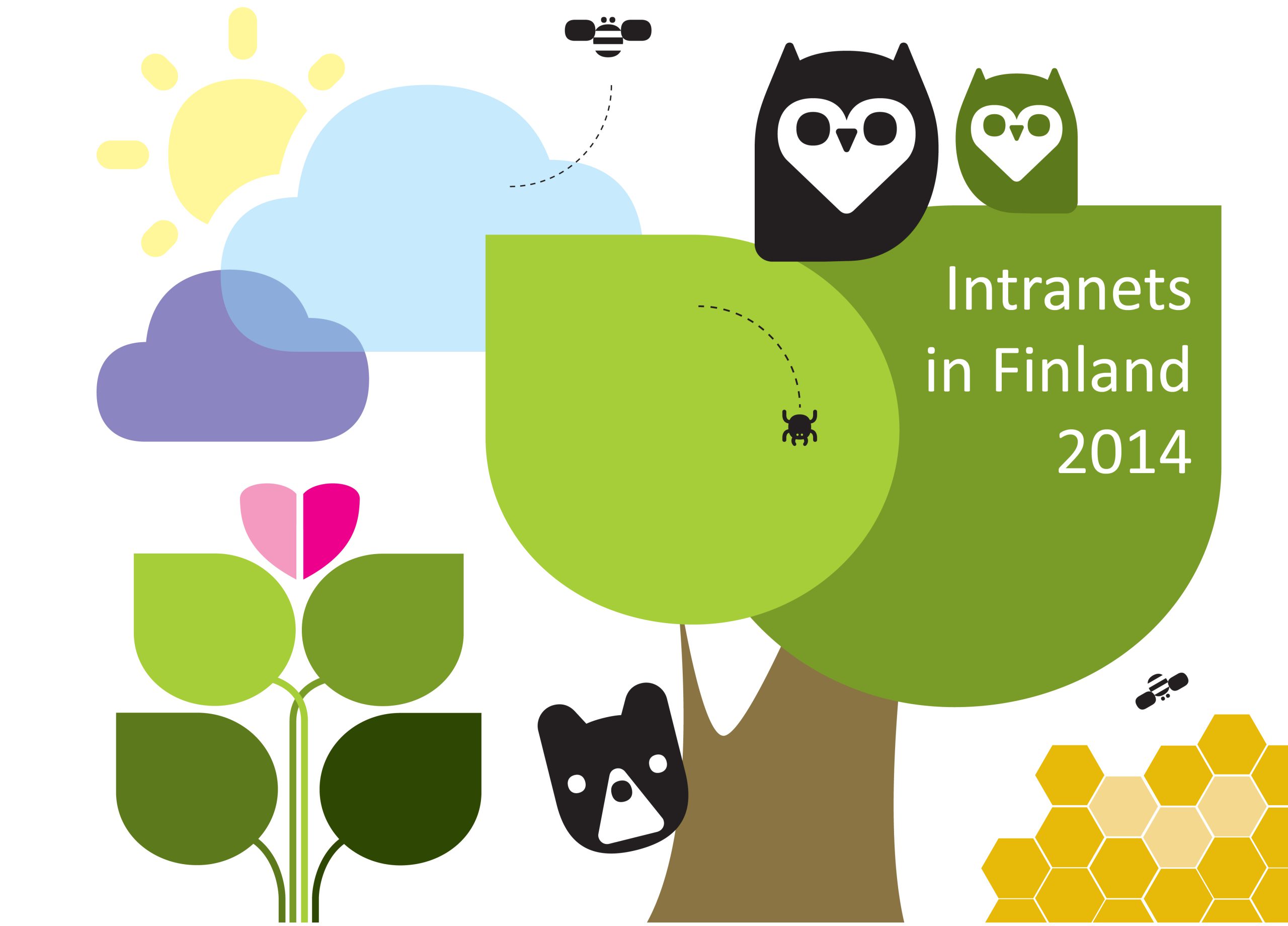Intranets are rising in importance but still lack strategic management, the first comprehensive study on Finnish intranets finds. The study, Intranets in Finland 2014, gathered responses from Finnish intranet managers. In addition to mapping the intranet technology, the survey studied the role and use of intranets and how intranets are managed, the typical content and features, as well as the role of the intranet managers and the emerging trends in the field.
North Patrol is a consulting firm specialized in the design of digital services and information systems. We shape ideas into a vision and service concept, find the best architectural and technological solutions, design a functional user experience, and compete to find the ideal partner for implementation work. We do not sell implementation projects, nor do we sell licenses; we are genuinely on the side of the customer.

The study found six emerging megatrends in Finnish intranets:
- Mobility
- Social
- Collaboration
- Management
- Transparency
- Video
1. Breakthrough of mobile
A mobile revolution of intranets is about to happen very soon. The opportunity to use their intranet with mobile devices will revolutionize the use of intranets for employees not working at a desk (blue-collar workers).
Currently, two out of five intranets in Finland are accessible with mobile devices. Half of the respondents say that making intranet accessible for mobile devices is one of the most important issues to deal with in the future. This is the case especially in private businesses, which represent half of the respondents of the study.
2. Increasingly social features
Social features on intranets are already very common. Currently, however, they tend to be quite limited—for example having a possibility to comment only on intranet news.
Social is now turning a new leaf. The new social intranets are all about having social elements integrated into every feature and functionality. People you work with are present on the intranet with their own faces and with their own thoughts, through, for example, blogging, sharing, and in collaboration tools.
According to the survey, especially the following social and community features of intranets are raising in importance: using intranet for praising co-workers and rewarding for work well done, building up Q&A sections, commenting, generating and sharing ideas and initiatives, editing team documents, publishing your own content (such as blogs), publishing your personal profile, and liking various items. All these eight features make it to the top-10 of features rising in importance. All in all, 40 features were studied (please see the end of the post for the comprehensive list).
3. Wider collaboration possibilities
Team sites, group workspaces, and other tools to support team and project collaboration are quite commonly found on Finnish intranets. Organizations provide the sites or spaces for teamwork either as part of the common intranet or on a special platform separate from the traditional intranet.
Only one in four respondents say they have made it possible to invite external participants to the spaces or sites on their intranet, but half of the respondents say the possibility to do so is becoming more important in the future.
Especially editing team documents on intranets is a feature to be developed if it is not yet possible.
4. Integration into operational management
Using intranet as a leadership and operations management tool is a fast advancing intranet concept, according to the study. The intranet is becoming a more integrated part of the toolbox for organizational management.
The thoughts and ideas of top management, middle management, employees—and now also the clients— are pulled together on intranets into a common dialogue. Management has become social and transparent on intranets; managers are present with their own faces like all other members of the organization.
An increasing number of Finnish intranets are used for praising co-workers and rewarding for work well done, giving information behind decisions, generating and sharing ideas, handling and publishing feedback from clients, and for publishing market and competitor data.
These features are overwhelmingly important in the trade and services, as well as the banking, finance and insurance sectors compared with any other sectors.
In the service sector, sharing knowledge in an organized way on intranets will help bring the tacit knowledge of employees to light, and build the information and knowledge capital of the organization.
5. Emphasis on transparency
The principle of transparency and openness is growing in importance, according to the study. Transparency and openness means giving all users the same access rights to content and the same publishing rights to discussions, commenting, and blogging.
Most of the organizations studied have made their intranets remotely available.
Also, most of the organizations have made all of their collaboration workspaces or team sites available for every employee to follow. The smaller the organization, the more typical this principle of transparency is.
In the future, according to the respondents, the intranet features boosting the transparency of the organization will become even more important. These features include generating and sharing ideas and initiatives.
As an interesting curiosity, even the heavily regulated banking, finance and insurance sector is about to take the principles of openness in use.
6. Video content exploding
Video content is published only on less than half of today’s intranets. Large organizations have been the first to introduce the use of video.
The use of video content is increasing significantly. Three of four respondents state that they will increase the use of video on their intranets. Videos are the 3rd most rising in importance of the 40 features studied.
In conclusion: Intranets are becoming increasingly important but lack strategic management
Finnish intranets are becoming a more integral part of the toolbox for organizational management. Intranets are no longer just internal newspapers and tools for publishing HR and other guidelines. A rising number of Finnish intranets are used for teamwork, praising co-workers and rewarding for work well done, giving information behind decisions, for generating and sharing ideas, handling and publishing feedback from clients, and for publishing market and competitor data.
But while the Finnish intranets are rising in importance they currently lack strategic management: according to the study, only 23% of Finnish intranets are strategically managed.
TOP-10 features on Finnish intranets
According to the respondents, the following features, content types, or functionalities of the 40 features studied are the most common in Finnish intranets.
- Events calendar
- Links to common tools
- Phone book
- About section and organizational guidelines
- Collaboration spaces/sites for organizational units and teams
- Collaboration spaces/sites for cross-organizational teams and projects
- Intranet replaces email as an internal news tool
- Lunch menus
- Media monitoring results
- The most important business indicators and figures
TOP-10 features rising on Finnish intranets
According to the respondents the following features, content types, or functionalities of the 40 features studied are the ones mostly rising in importance.
- Q&A sections
- Praising co-workers and rewarding for work well done
- Video content
- Commenting on content
- Intranet replaces email as an internal news tool
- Generating and sharing ideas and initiatives
- Editing team documents
- Publishing your own content, such as blogs
- Publishing your personal profile
- Liking content
TOP-5 technologies of Finnish intranets
Finnish intranets are built on the following technologies:
- 21% Microsoft SharePoint 2010
- 20% Microsoft SharePoint 2013
- 7% Atlassian Confluence
- 6% Liferay
- 5% Microsoft SharePoint MOSS 2007
- 40% other
The following platforms and systems were mentioned: Alfresco, Crasman, Drupal, Elevation, EPiServer, Humap inspiration platform HIP, IBM Notes/Domino, InfoWeb, Magnolia, Microsoft Office 365 / SharePoint in the cloud, Microsoft Sharepoint services 3.0, Midgard, Oracle Portal / UMC, Plone, Prime, self-developed, SharePoint2003, Stato, WebSphere, WordPress, Yammer.
About the survey
This was the first time the Intranets in Finland survey was conducted. It ran from May 6 to June 8, 2014 and had 113 respondents from at least 94 different organizations representing all industries and business sectors, in sizes ranging from under 50 to over 10,000 employees. The survey included 36 questions.
